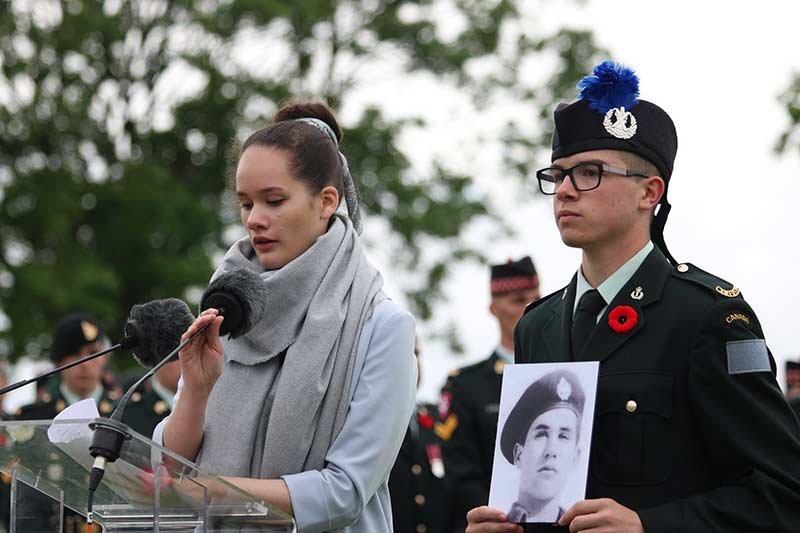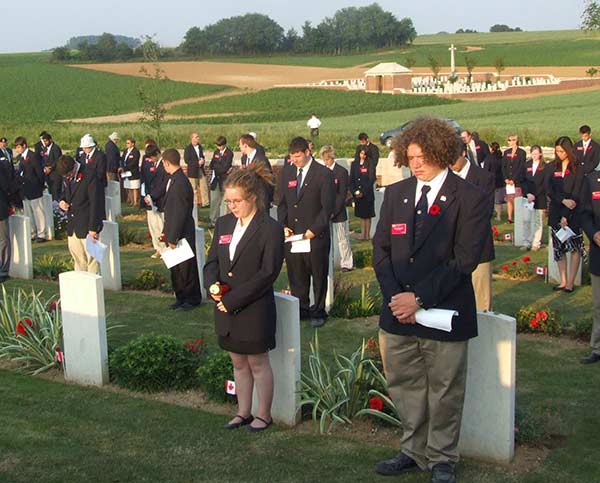A Guide to Commemorative Ceremonies
This publication is available upon request in alternate formats.
PDF Version
Introduction
Every November during Veterans’ Week, schools and community groups across Canada hold ceremonies to remember the sacrifices and achievements of those who have served our country in uniform. Events like these that pass on the traditions of remembrance are also important ways to show our appreciation to Veterans and their families. This resource offers some ideas on how commemorative ceremonies can be organized, but may be modified according to the resources available.

A member of the Canadian Armed Forces holds the Eagle Staff during a ceremony on Indigenous Veterans Day, November 8, 2017. Photo: VAC
Suggested sequence of events
- Vigil sentries take position
- Military parade and/or entry of Colour Party
- Arrival of special guests/dignitaries
- National anthem
- Opening remarks
- Last Post, two minutes of silence, and Rouse
- Act of Remembrance
- Commitment to Remember
- Prayers and/or sacred traditions
- Recitation of poems and/or special presentation
- Laying of wreaths
- Conclusion
Vigil sentries take position
Your school or community group may wish to include vigil sentries to stand at the four corners of a memorial or other appropriate display. In traditional ceremonies, these sentries take their posts before the start of the ceremony. Likewise, they remain in place until its conclusion and any dignitaries or the military parade have departed. At the National Remembrance Day Ceremony in Ottawa, these sentries are Canadian Armed Forces members and RCMP officers. Some schools and community groups choose to have Sea, Army and Air Cadets–or even Scouts and Girl Guides in uniform–stand as sentries.
Military parade and/or entry of Colour Party
In traditional ceremonies, the Colour Party (flag bearers) is accompanied by a military marching band. A school or community group may wish to have students carry flags while the school choir or band performs an appropriate song. Although the Canadian flag is lowered during the National Remembrance Day ceremony in Ottawa at 11 am, people often choose to lower the Canadian flag to half-mast from sunrise to sunset on November 11.
Arrival of special guests/dignitaries
If you have invited special guests such as Veterans, Canadian Armed Forces (CAF) members or local politicians, you may wish to have a Master of Ceremonies (MC) announce their arrival and have someone guide them to a designated seating area, usually at the front facing the ceremony area.
National anthem
The MC invites everyone to stand for the singing of O Canada.
Opening remarks
Commemorative ceremonies are solemn in nature. The opening remarks are a time to set the tone of the event. It is also a good time for the MC to welcome everyone and introduce special guests and dignitaries.
Last Post, two minutes of silence, and Rouse
The Last Post, two minutes of silence and the Rouse take place one after the other, without interruption. The MC may want to explain this prior to the playing of the Last Post, especially if the audience is younger and this is their first commemorative ceremony. The National Remembrance Day Ceremony is timed with precision so that the Canadian flag is lowered and the Last Post is finished at exactly 11 am, marking the beginning of the two minutes of silent reflection and the 21-gun salute. This timing–the eleventh hour of the eleventh day of the eleventh month–has great symbolic significance. This was when the armistice ending the fighting of the First World War went into effect on 11 November 1918.
The Last Post is a bugle call that was traditionally used to tell the troops at an army camp that the last guard post had been inspected and the rest of the soldiers could go to sleep for the night. As it marked the end of the day, it came to also symbolize those who had died in service and calls us into remembrance during the two minutes of silence (symbolizing the night). In contrast, the Rouse is a morning wake-up bugle call and came to symbolize the awakening to a better world. Sometimes, a bagpipe lament will be played after the two minutes of silence, prior to the Rouse.
You may wish to have a trumpeter or bugler from your school or group play these songs, but there are also many recordings available.
Act of Remembrance
The Act of Remembrance is normally recited by a Veteran (if one is present) in English, French and an Indigenous language, if possible. You may also wish to add another language commonly used in the community.

A Canadian youth delivers a presentation on a fallen soldier during a ceremony at Bretteville-sur-Laize Canadian War Cemetery in Normandy, France. Photo: VAC.
They shall grow not old, as we that are left grow old;
Age shall not weary them, nor the years condemn.
At the going down of the sun and in the morning
We will remember them.
All respond: We will remember them.
Commitment to Remember
The Commitment to Remember is normally recited by a young person in English, French and an Indigenous language, if possible. Again, you may also wish to add another language common in your community.
They were young, as we are young.
They served, giving freely of themselves.
To them, we pledge, amid the winds of time,
To carry their torch and never forget.
We will remember them.
All respond: We will remember them.
Prayers or sacred traditions
Depending on the faith beliefs of your school or community, a prayer, blessing or sacred tradition such as an Indigenous smudging ceremony may be incorporated at this point in the ceremony.
Recitation of poems or special presentations
Schools and community ceremonies will often feature young people reciting a remembrance poem, such as In Flanders Fields. They may also share poems they have written themselves. Sometimes, a Veteran or other special guest will speak about the importance of remembrance, or an appropriate video will be shown.
Laying of wreaths
If wreaths are going to be laid during the service, appropriate music such as In Flanders Fields may be performed by a band or choir.
In traditional ceremonies, the wreath is usually carried by a member of the military walking alongside the person who is to lay the wreath. The two approach, briefly pause, exchange the wreath, place it (often on a stand), step back, pause for a moment (military personnel will salute), turn to the right and walk off. If you have dignitaries present, wreaths are usually laid following the Table of Precedence for Canada. For a less formal ceremony, youth representatives could lay wreaths on behalf of their classes or certain groups.
Ceremony conclusion
The MC may wish to thank everyone for their attendance, especially the special guests and the organizers. In traditional ceremonies, the MC will invite everyone to sing God Save the King prior to the departure of the dignitaries and the marching out of the Colour Party and military parade.
Candlelight tribute ceremonies

Canadian youth gather for a candlelight tribute ceremony near Beaumont-Hamel, France. Photo: VAC
The tradition of lighting candles at the graves of fallen Canadian service members has become an annual tradition in the Netherlands on Christmas Eve to pay tribute to those who died liberating their country during the Second World War. It is a powerful way to honour those who sacrificed their lives for freedom.
Organizing a candlelight tribute ceremony
A candlelight tribute ceremony at a cemetery where Veterans or fallen service members are buried can follow the same order as outlined above with the addition of a candle lighting and placement component, usually after the opening remarks. When possible, a meaningful aspect of this type of ceremony comes by having the older generation (e.g. Veterans, Canadian Armed Forces members, dignitaries or teachers) give lit candles to the younger generation, symbolizing the passing of the “Torch of Remembrance.” Each young person then places their candle at a tombstone and remains at the foot of that gravesite throughout the remainder of the ceremony. Here are some additional tips:
- When choosing the cemetery location, such as a Veteran section of a local cemetery, be sure to obtain prior permission from the appropriate authorities.
- Determine how many candles you will need based on the number of individuals you will be honouring. Real tea lights in fire-resistant holders provide a nice effect, but they can be challenging to use in adverse weather. If this is a concern, consider using battery operated candles.
- Choose a time of day when the sun is setting. At dusk, the lit candles provide a warm and reflective ambiance to the ceremony.
- Determine if you will need chairs for the participants, and arrange for setting them up.
- Plan where people will stand or sit, and where the candles will be placed. If multiple generations will be present and there is a Cross of Sacrifice or other monument in the cemetery, consider having the younger and older people on opposite sides.
- Prior to the ceremony, distribute lit candles to the older generation who will be the “torch bearers.” If using real candles, have someone with a lighter stand by to help relight any candles that go out.
- If there are more youth participants than older participants, one option is to pre-select a number of young people to symbolically receive a candle from a torch bearer. The remaining candles could then be distributed to their peers in an organized fashion. Another option would be for the selected youth to receive multiple candles and then pass them along to others.
- Once all of the candles are distributed, the youth are directed to the graves where candles are to be placed. It is good to have a leader walk to the end of each row, with participants falling in behind and then stopping at their grave marker, facing the side of the headstone bearing the inscription.
- On command, the candle bearers can step forward as a group to place their candles on top or in front of their grave markers. Have them ensure that the candles are stable and unlikely to fall.
- The torch bearers and other people in attendance can remain standing near the Cross of Sacrifice, other monument or at the front of the cemetery where they can see the youth at the graves.
- At the conclusion of the ceremony, the youth can spend time with the Veterans, Canadian Armed Forces members, teachers and guests while they visit the headstones.
- As a follow-up activity, youth could learn more about the person buried at “their” gravesite. Information about those who died in service can be found on the Canadian Virtual War Memorial. For Veterans buried in cemeteries in your community, students may wish to try researching local archives or obituaries.
- Date modified: